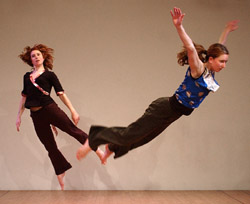A bold sketch of fierce arms and low, lusty lunges, Serge Bennathan’s Elles is the fourth dance work to win the Rio Tinto Alcan Performing Arts Award over the last dozen years (the prize alternates with theatre and music). The award comes with a coveted $60,000 prize, which helped to fund the presence of eight women dancers currently living in Vancouver, Winnipeg, Toronto and Montréal. Valerie Calam, Alison Denham, Erin Drumheller, Susan Elliott, Darcy McMurray, Ali Robson, Linnea Swan and Carolyn Woods form an ensemble with a range of contemporary dance training, experience and ages (from twenties to forties).
Since moving to Vancouver after directing Toronto’s Dancemakers from 1990-2006, Bennathan has worked a lot with actors and text (notably in 2007’s The Invisible Life of Joseph Finch starring Jonathon Young), and even though Elles is pure dance, a sense of drama and character brims under the surface. The dramatic backbone on which he hangs the choreography is the iconic ballet Giselle –- or so it seemed to me, because before heading out to the Vancouver East Cultural Centre for the premiere, I read a Georgia Straight newspaper preview now posted on Bennathan’s website (lesproductionsfiglio.ca), in which he explains that the vengeful sisterhood of wilis who haunt Giselle was his initial inspiration for Elles. Despite there being no note about the Romantic ballet in the program and no obvious link in the title, beyond the bit of wordplay, the wilis clearly haunt Bennathan’s expressive, barefoot dance.
There are definite nods to Giselle in Bennathan’s staging. A forest glade is evoked by Jay Gower Taylor’s lovely backdrop of trees, painted on crinkled brown paper that soaks up James Proudfoot’s lights. Bertrand Chenier’s piano score, which he played live, is a romantic Chopinesque cascade (sometimes effectively set under recorded sections of electronic or world music). Finally, the dancers are part-woman, part-creature, a close tribe who huddle together and follow each other about like the hordes of ghostly wilis in Giselle. There’s even a recurring reference to the little wings traditionally attached to the bodices of the wilis’ long tutus. When the group lifts Elliott high above them, one woman flutters her hands by Elliott’s back. Another time, everyone pairs off, each of the women fluttering her hands behind her partner’s back. The motif is almost too literal within the abstract dance, but is more distilled poetry than the pure mime used in nineteenth-century story ballets.
Another layer of inspiration apart from Giselle is revealed in the first line of Bennathan’s brief program note: “Elles is the beginning of an exploration of an emotional history of dance through bones, muscles, and mind.” His autobiographical The Strange Adventure of Myself, performed by Sylvain Senez at its premiere in 2009, explored Bennathan’s own history of dance through choreographed bones and muscles; Elles continues this interest in personal history by privileging the dancers’ individuality over the group’s uniformity. This is evident on stage in the way Bennathan allows the women their own interpretation of every swooping move and fierce jeté, including their own timing. Of course, this is quite the opposite of the strict timing and shapes of Coralli and Perrot’s choreography for the wilis, who are white, shadowy beings blindly following Myrtha, their imperious queen.
The opening to Elles is a perfect example of the edgy texture Bennathan creates by having each woman follow her own impulse. The dancers stand in a line, eyes shut, slowly moving through a second position grand plié with full port de bras. We get the same choreography but with very different line, dramatic shading and timing from each one. It might have looked ragged except that the performers are focussed and sure.
Linda Chow’s costumes, a range of black and grey pants and tops, are similarly styled with the same overall aesthetic but with individual touches. The somber colours suggest Bennathan’s interest in the darker aspects of wili behaviour: they are, after all, known to send the men who happen upon them in the night to their death. Elles is filled with spiky-fingered, muscular port de bras and emphatic solos. Calam’s alternately flat-footed and tippy-toed stamping, like a toreador facing a bull, is a magnificent showcase of finely etched fury.
The sudden change in aesthetic for the last section, set to a hard dance beat, seemed an arbitrary decision. Gone is the detailed, full-body choreography; instead we have the ensemble jumping straight up and down while individuals take turns skipping forward, hips and knees loose. In the last moments we return to the more evocative world set in the forest glade, as the women stand facing upstage, their deep breaths causing their bared backs to pulse in and out, spines and ribs revealed, the inner and outer body exposed.
Elles might helpfully have been subtitled ou Les Wilis, as Giselle originally was; I’m not sure my imagination would have been as sparked and alive without the background information, and obviously not everyone read the preview. “There is nothing to understand,” Bennathan says in the second and last line of his program note, “but everything to feel.” Perhaps the emphasis on feeling is in response to the way modern dance is sometimes still dismissed as strange and hard to figure out, yet clearly there are ideas behind Elles. I’m glad to have been pointed toward the wilis: it’s fun to feel AND to have something to keep the brain cells ticking over.
Tagged: Contemporary, Performance, BC





